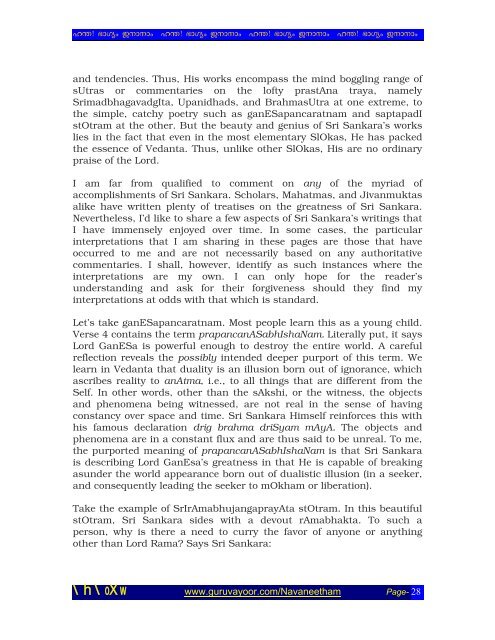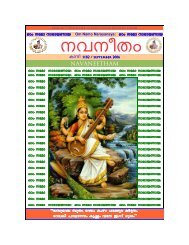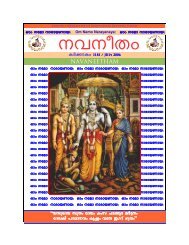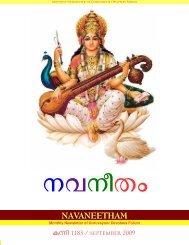Navaneetham - Guruvayoor / Guruvayur
Navaneetham - Guruvayoor / Guruvayur
Navaneetham - Guruvayoor / Guruvayur
You also want an ePaper? Increase the reach of your titles
YUMPU automatically turns print PDFs into web optimized ePapers that Google loves.
pÉ! g¡L¬« Qc¡c¡« pÉ! g¡L¬« Qc¡c¡« pÉ! g¡L¬« Qc¡c¡« pÉ! g¡L¬« Qc¡c¡«<br />
and tendencies. Thus, His works encompass the mind boggling range of<br />
sUtras or commentaries on the lofty prastAna traya, namely<br />
SrimadbhagavadgIta, Upanidhads, and BrahmasUtra at one extreme, to<br />
the simple, catchy poetry such as ganESapancaratnam and saptapadI<br />
stOtram at the other. But the beauty and genius of Sri Sankara’s works<br />
lies in the fact that even in the most elementary SlOkas, He has packed<br />
the essence of Vedanta. Thus, unlike other SlOkas, His are no ordinary<br />
praise of the Lord.<br />
I am far from qualified to comment on any of the myriad of<br />
accomplishments of Sri Sankara. Scholars, Mahatmas, and Jivanmuktas<br />
alike have written plenty of treatises on the greatness of Sri Sankara.<br />
Nevertheless, I’d like to share a few aspects of Sri Sankara’s writings that<br />
I have immensely enjoyed over time. In some cases, the particular<br />
interpretations that I am sharing in these pages are those that have<br />
occurred to me and are not necessarily based on any authoritative<br />
commentaries. I shall, however, identify as such instances where the<br />
interpretations are my own. I can only hope for the reader’s<br />
understanding and ask for their forgiveness should they find my<br />
interpretations at odds with that which is standard.<br />
Let’s take ganESapancaratnam. Most people learn this as a young child.<br />
Verse 4 contains the term prapancanASabhIshaNam. Literally put, it says<br />
Lord GanESa is powerful enough to destroy the entire world. A careful<br />
reflection reveals the possibly intended deeper purport of this term. We<br />
learn in Vedanta that duality is an illusion born out of ignorance, which<br />
ascribes reality to anAtma, i.e., to all things that are different from the<br />
Self. In other words, other than the sAkshi, or the witness, the objects<br />
and phenomena being witnessed, are not real in the sense of having<br />
constancy over space and time. Sri Sankara Himself reinforces this with<br />
his famous declaration drig brahma driSyam mAyA. The objects and<br />
phenomena are in a constant flux and are thus said to be unreal. To me,<br />
the purported meaning of prapancanASabhIshaNam is that Sri Sankara<br />
is describing Lord GanEsa’s greatness in that He is capable of breaking<br />
asunder the world appearance born out of dualistic illusion (in a seeker,<br />
and consequently leading the seeker to mOkham or liberation).<br />
Take the example of SrIrAmabhujangaprayAta stOtram. In this beautiful<br />
stOtram, Sri Sankara sides with a devout rAmabhakta. To such a<br />
person, why is there a need to curry the favor of anyone or anything<br />
other than Lord Rama? Says Sri Sankara:<br />
\h\oXw www.guruvayoor.com/<strong>Navaneetham</strong> Page- 28





